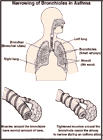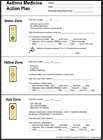
Asthma
Admission Information and Discharge Instructions
What is asthma?
Asthma is a chronic (ongoing) lung disease in which the lining of the airways of the lungs is swollen or inflamed. The airways are unusually sensitive to certain irritants or "triggers." A trigger can be an irritant such as a cold virus, tobacco smoke, or cold air. An asthma trigger can also be something your child is allergic to such as pollen, animal dander, or house dust. When the airways react to a trigger, the muscles around the airways tighten and the lining of the airways swells and produces a thick mucus. This causes the airway to narrow and makes it harder to breathe. This breathing difficulty is called an asthma attack. An asthma attack can be mild, moderate, or severe. When your child is having an attack, medicine will help control the symptoms.
Asthma does not go away when your child is not having symptoms. Your child needs to have a treatment plan and close follow-up by a health care provider.
What are the symptoms?
Symptoms of asthma may come and go and may include:
- wheezing (a high-pitched whistling or musical sound while breathing out)
- coughing
- chest tightness
- trouble breathing
- trouble breathing or coughing during or after exercise.
Why was my child admitted to the hospital?
Main complication:___________________________________________
___ Needs frequent or continuous medication to ease breathing.
___ Needs oxygen or other medicine.
___ Needs IV fluids.
___ Other reason: ____________________________________________
How long does it last?
Asthma can be a long-lasting disease, but more than half of young people who have asthma experience a significant decrease in symptoms during adolescence. Asthma attacks may be frightening, but they are treatable. When medicines are taken as directed, the symptoms completely clear up.
What are the requirements for discharge?
- _______________________________________________________
- _______________________________________________________
- _______________________________________________________
What type of medicine does my child need?
Quick-relief medicine
Quick-relief medicines quickly open your child's airways and are used when your child is having an asthma attack. These medicines are called bronchodilators.
If your child is having asthma symptoms, he should take his quick-relief medicine. If you have any doubt about whether or not your child is wheezing, have your child start taking his asthma medicine. The later medicines are begun, the longer it takes to stop the wheezing. Once treatment with the medicine is begun, keep giving your child the quick-relief medicine according to the dose prescribed by your health care provider. (Your child may need to take the quick-relief medicine for several days.)
Controller medicines
Controller medicines help keep the airways in your child's lungs from becoming inflamed and irritated and help prevent asthma attacks.
Children with the following symptoms usually need to take controller medicines every day to allow them to participate in normal activities:
- 2 or more attacks of wheezing per week
- 3 or more nighttime attacks a month
- asthma flareups lasting several days
- 3 or more visits per year for urgent medical care despite proper use of inhaler
- asthma triggered by pollens (may need to use daily asthma medicines during the entire pollen season).
How can I take care of my child?
- Hay fever. For hay fever symptoms, it's OK to give antihistamines. Poor control of hay fever can make asthma attacks worse. Research has shown that antihistamines don't make asthma worse and may improve asthma control.
- Colds. Most children with asthma wheeze when they get coughs and colds. If this is true for your child, give your child his quick-relief asthma medicine at the first sign of any coughing or wheezing. The best "cough medicine" for a person with asthma is an asthma medicine, not a cough syrup. You should watch your child carefully when he has a cough or cold and call your health care provider for advice if he is not improving after taking asthma medicine or if the symptoms are getting worse.
- Exercise. Most people with asthma get 15- to 30-minute attacks of coughing and wheezing when they exercise strenuously. Prolonged vigorous exercise such as long distance running, especially in cold air, is a major trigger. In most instances this problem should not interfere with participation in most sports or require a gym excuse, unless your child is recovering from a viral illness and needs a few days to fully recover. Your child can usually avoid the symptoms by using a quick-relief medicine 15 to 30 minutes before exercise. If your child still has frequent symptoms with exercise even after using a quick relief medication, you should discuss your concerns with his health care provider.
- Going to school. Asthma is not contagious. Your child should go to school if he is having mild asthma symptoms, but should avoid gym or vigorous activity on these days. Arrange to have the asthma medicines, a peak flow meter, and an Asthma Action Plan at school. The Asthma Action Plan should be developed with your health care provider and outline what to do if your child experiences asthma symptoms while at school. If your child can't go to school because of asthma, take him to your health care provider that same day for advice about additional treatment.
- Common mistakes. The most common mistake is delaying the start of prescribed asthma medicines or not replacing them when they run out. Nonprescription inhalers and medicines are not helpful.
Another serious error is continuing to expose your child to an avoidable cause of asthma. For example, do not keep a cat if your child is allergic to it. Also, do not allow smoking in your home. Tobacco smoke can linger in the air for more than a week. When your child is having an asthma attack, don't panic. Fear can make tight breathing worse, so try to remain calm and reassure to your child. Finally, try not to let asthma restrict your child's activities, sports, or social life. If your child's asthma symptoms are worsening and affecting his lifestyle make an appointment to discuss your concerns with your health care provider. A change or increase in asthma medications may be necessary to gain better control of your child's asthma.
Other medicines
For pain or fever over 102°F (39°C) give ______________________________
_______________________________________________________________
_______________________________________________________________
Additional instructions
_________________________________________________________________
_________________________________________________________________
_________________________________________________________________
How can asthma attacks be prevented?
- Try to discover and avoid the substances that trigger your child's asthma attacks. Second-hand tobacco smoke is a common trigger. If someone in your household smokes, your child will have more asthma attacks, take more medication, and need more emergency room visits.
- Try to keep pets outside or at least out of your child's room.
- Learn how to dust-proof your child's bedroom. Change the filters on your hot-air heating system or air conditioner every two weeks or at least monthly.
- For allergies to molds or carpet dust mites, try to keep the house humidity less than 50%. Consider using a dehumidifier if necessary.
- If your child wheezes after any contact with grass, weeds, or animals, there may be pollen or animal dander remaining in your child's hair or on his clothes. Your child should shower, wash his hair, and put on clean clothes.
When should my child be seen again?
___ Your child needs to be rechecked and has an appointment on _____________ at _______ with _________________________.
___ Your child needs to be rechecked in ________ days. Call your child's doctor to make an appointment.
___ A follow-up appointment is not necessary. Call the doctor if you have any concerns.
When should I call my child's health care provider?
Call IMMEDIATELY if your child:
- has severe wheezing
- is having trouble breathing
- has wheezing that has not improved after the second dose of asthma medicine
- needs to use the inhaler more than every 4 hours
- the peak flow rate is less than 50% of the personal best.
Call within 24 hours if:
- The wheezing is not completely gone in 5 days.
- You have other questions or concerns.


